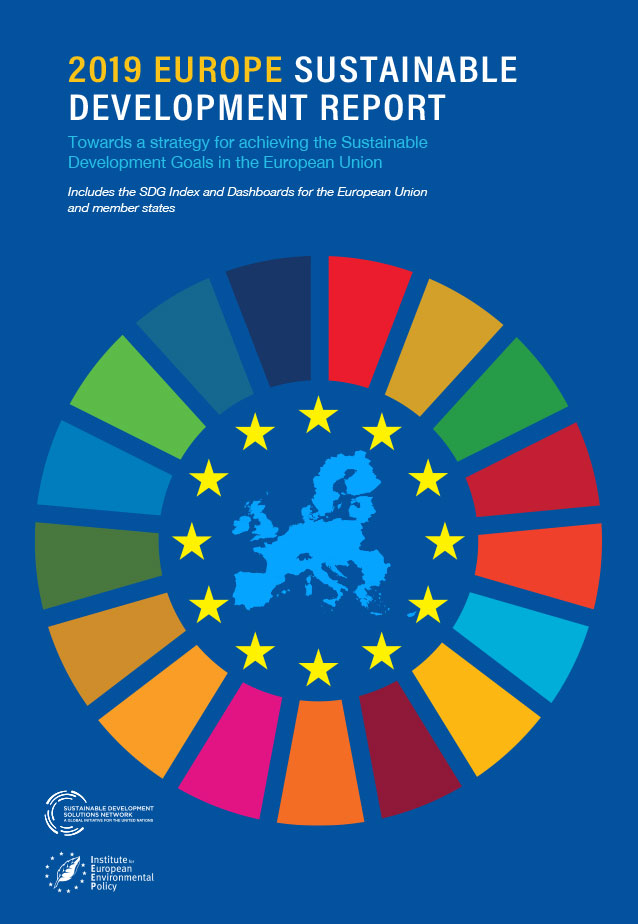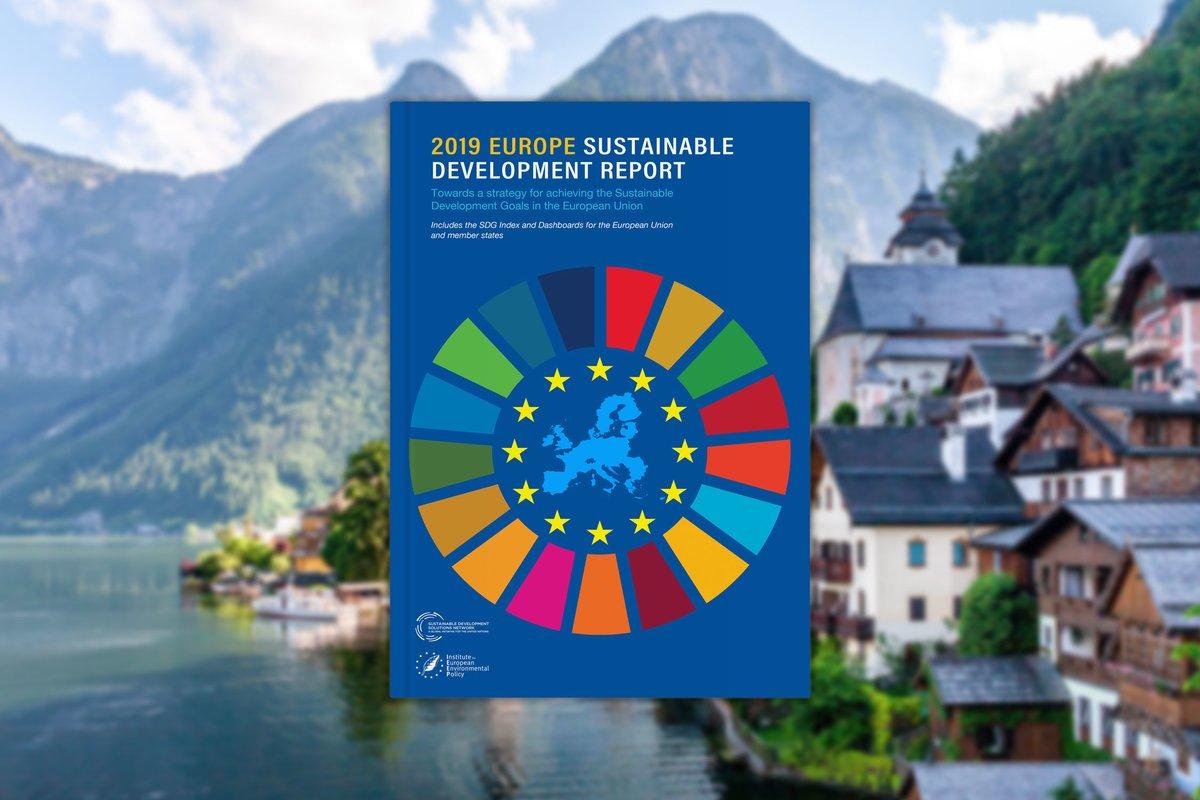AUTHORS: Céline Charveriat – Marianne Kettunen – Guido Schmidt – Guillaume Lafortune
The 2019 Europe Sustainable Development Report compares the performance of the EU and its 28 member states on all 17 SDGs and provides detailed country profiles using a mix of data sources.
The report is produced by the Sustainable Development Solutions Network and the Institute for European Environmental Policy, with the support of the Heinrich-Böll-Stiftung European Union, and in cooperation with the European Economic and Social Committee (EESC) and the Finnish Presidency of the Council.
Summary of findings and recommendations
The 17 Sustainable Development Goals (SDGs), agreed globally by all 193 UN member states, represent an affirmation of European values. The SDGs call on all nations to combine economic prosperity, social inclusion, and environmental sustainability. The SDGs are intimately linked with the Paris Climate Agreement (which is incorporated in SDG 13). The SDGs and the Paris Climate Agreement should be viewed as a package, with the SDGs oriented towards 2030 and the Paris Agreement oriented towards climate-neutrality by 2050, with major progress by 2030.
 The report covers all EU The report covers all EU Member States and includes an interactive dashboard with data on their performance on each of the 17 SDGs |
The EU and its member states face the greatest challenges on goals related to climate, biodiversity, and circular economy, as well as in strengthening the convergence in living standards, across countries and regions. In particular, countries need to accelerate progress towards climate change (SDG 13), sustainable consumption and production (SDG 12), protection and conservation of biodiversity (SDGs 14 and 15), and sustainable agriculture and food systems (SDG 2). Many countries are falling back on “leave no one behind”, so the EU’s SDG strategy must place emphasis on strengthening social inclusion for all people living in its territory. Education and innovation capacities must be improved to raise living standards in poorer member states and accelerate the convergence in living standards.
European countries lead globally on the SDGs, but none are on track to achieve the Goals by 2030. According to the global 2019 SDG Index prepared by the Bertelsmann Stiftung and the Sustainable Development Solutions Network (SDSN), all ten countries closest to achieving the SDGs are in Europe, a truly remarkable performance in the international perspective. Yet, as the EU SDG Index and Dashboards show, no European country is on track towards achieving the goals.
European countries also generate large, negative spillovers that impede other countries’ ability to achieve the SDGs. Such spillovers comprise environmental spillovers (such as greenhouse gas emissions or biodiversity loss embodied in trade), financial and governance spillovers (such as banking secrecy), and security spillovers (such as weapons exports). The EU’s SDG strategy must identify and address negative international spillovers.
The SDGs can only be achieved through deep transformations that will not be achieved through normal policymaking. The transformation will need long-term plans and policies based on:
- Technological Pathways: to identify one or more technology scenarios to reach climate neutrality by 2050, including intermediate milestones for five-year periods;
- Financial planning: to identify efficient and low-cost pathways among the possible alternatives;
- Policy frameworks: to identify a feasible mix of regulations, public investments, and incentives;
- Subsidiarity analysis: to assign policy and financing responsibilities across levels of government, including the EU level (Commission, Council, Parliament, European Investment Bank), member states, and regional and local governments in the EU.
- Mission-oriented Research and Innovation: to identify public-private research and development priorities to achieve the SDGs and the objectives of the Paris Agreement;
- Metrics and Monitoring: to identify a set of indicators to assess progress towards the 2050 goal and intermediate milestones, and to create an ongoing feedback process from metrics to policy.
An EU strategy to achieve the SDGs needs to focus on three broad areas: internal priorities, diplomacy and development cooperation, and tackling negative international spillovers. The good news is that the necessary instruments already exist to address these challenges. The focus should therefore not be on identifying new instruments but in aligning existing instruments and mechanisms (including budget, investment strategies, regulatory governance, and monitoring frameworks) to the SDGs.
Priority I: Internal SDG priorities for the EU and member states.
The new European Commission, working with the European Parliament and the European Council, has the vital role to ensure that EU processes are in place to achieve the SDGs, including under the framework of the European Green Deal. Based on the SDG Index data, we identify three primary EU-wide SDG priorities to be pursued with all member states. Individual countries may need to tackle additional challenges.
- A European Green Deal for Sustainable Energy, Circularity, and Land Use & Food. At the heart of the EU’s strategy to achieve the SDGs, the European Green Deal must include an EU-wide strategy to (i) fully decarbonise the energy system (including transport, building, and industry) by 2050; (ii) to promote the circular economy and achieve greater efficiencies in resource use and far lower waste; and (iii) develop integrated policies to promote sustainable land use and food systems by 2050. Getting towards the 2050 objectives will of course require urgent action now.
- A Sustainable Europe Investment Plan. The EU needs to increase investments in sustainable infrastructure, including through greater EU resources. New sources for public revenues should be considered to finance the investment plan, which will require adequate resourcing.
- Skills and Innovation: EU Education Area and Horizon Europe 2030. Europe needs to increase investments in education, job skills, and innovation, with a focus on STEM education at all levels and R&D for sustainable technologies. Just as China has its Made in China 2025 Initiative and the U.S. has its America AI Initiative, Europe should intensify its R&D efforts.
Getting it done: Ensuring the right level of ambition and policy coherence. The policy mechanisms and instruments for addressing the internal SDG priorities are mostly in place, but policies need to become more ambitious in some areas and focus on 2030 targets, which the EU needs to define. Throughout, the EU needs to define clear targets that can guide policy implementation and the monitoring of progress. In the short term, policy tools must be made coherent with a particular focus on budgets, measurement and reporting, and coordination with and across member states:
- Aligning the Multiannual Financial Framework (MFF) 2021-2027 with the SDGs. The next MFF should be the MFF for the SDGs. This includes phasing out expenditures that are not aligned with the SDGs and increasing spending on sustainable development priorities. New MFF principles and their alignment with the SDGs should be integrated into all EU funds. The MFF should also identify clear SDG metrics that can track progress towards the goals.
- Strengthened SDG measurement and indicators. As we show in the report, monitoring frameworks across EU policy fields are not aligned with the SDGs and lack coherence. This can and needs to be changed quickly by identifying headline SDG indicators that should guide all tools, including budget, member state coordination, and external action. Moreover, Eurostat and other EU bodies charged with collecting SDG data will require greater resources to track key SDG data, including on international spillovers. Another important priority is better real-time data on the implementation of the European Green Deal and other critical SDG strategies.
- Putting the SDGs at the core of the European Semester. The scope of the European Semester should be expanded slightly to cover all major SDG dimensions. This will not require a major change since the European Semester is already meant to track social and several environmental targets; and a clear SDG focus should not divert attention away from macroeconomic coordination, which is also needed to achieve the SDGs. Member states might be requested to present their long-term national strategies in support of the European Green Deal and other SDG priorities – alongside macroeconomic policies and fiscal frameworks. The European Semester process would then map national strategies against EU-wide strategies to identify and address opportunities for greater alignment and flag issues arising out of implementation.
Priority II: European Diplomacy and Development Cooperation for the SDGs
European Diplomacy for the SDGs: The SDGs represent Europe’s values, so the EU should use them as part of its external action. Indeed, a critical part of Europe’s role in achieving the SDGs includes global leadership through diplomacy and international economic relations. The core areas for the EU’s SDG diplomacy are manifold and include:
- EU leadership for the SDGs in the international conventions, particularly the climate and biodiversity conventions, where the EU needs to push for climate and biodiversity neutrality by 2050.
- EU SDG leadership in multilateral forums to protect and strengthen multilateralism.
- Bilateral fora with key partners, particularly with the African Union (AU), Mercosur, China, Japan, North America, and Russia
- EU-China Partnership for Sustainable Investment. Europe should offer to link its own Sustainable Europe Investment Plan with the Belt and Road (BRI) Initiative, under the condition that BRI also adopts a sustainable investment framework.
European Sustainable Development Cooperation: The EU is the world’s biggest donor and contributor to climate finance. It now needs to align its development cooperation with the SDGs to serve the needs of emerging economies and poor countries. The EU should consider launching a bold AU-EU Partnership for African Education to help ensure that all African children are enabled to complete education.
Priority III: Tackling international spillovers
To ensure international legitimacy, the EU’s diplomacy and sustainable development cooperation must be coherent with its internal ambitions. This will require addressing negative international spillovers. The EU needs to systematically track such spillovers and assess the impact of European policies on other countries and the global commons. In particular, trade policies and decarbonisation strategies need to be reviewed with a view towards international spillovers. EU member states also need to make further efforts in curbing banking secrecy and unfair tax competition.
The SDGs are Europe’s goals and provide an ambitious vision through to 2030. The new Commission, working with the Parliament and member states, must launch the European Green Deal as a decisive framework for Europe’s sustainable development during the coming decade. Another part of Europe’s challenge is to create a highly innovative EU economy that will develop or improve the needed sustainable technologies and implement them on an accelerated basis throughout the EU. The EU has tremendous global influence through its intellectual and policy leadership, its lead in SDG implementation, and the fact that the EU is the world’s strongest champion of the rule-based multilateral order with the UN Charter, institutions, and treaties at the core. It should therefore pursue an ambitious SDG strategy that is coherent internally and externally.



